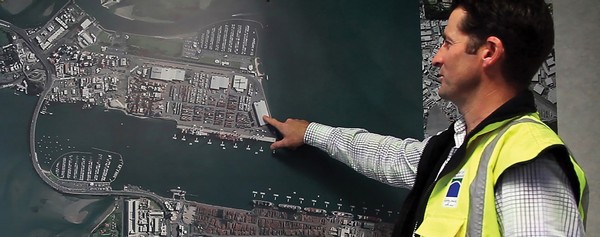Kawerau container terminal - demand nearly triples!

The town of Kawerau in the Eastern Bay of Plenty (EBoP) is unique. It boasts the world’s largest application of geothermal energy for industrial use, and provides the ideal environment and support for companies pursuing a sustainable way of operating. Couple that with a growing export manufacturing sector and strong primary industries and you have a region producing a wide variety of value-added products at the forefront of New Zealand’s growing export bioeconomy. Scion is working with EBoP businesses to find a new and more efficient way of transporting their products to the world.
Efficient transport
Industrial Symbiosis Kawerau (ISK) is a group of Kawerau-based organisations working together to find efficiencies and minimise waste between their diverse industries. They have been looking for an efficient way to transport the 30,000 20-foot equivalent containers of goods produced in the EBoP each year. At present, most of the cargo makes its way on trucks to the Port of Tauranga via State Highway 2 and containers are often packed at different locations along the way. The trucks travel alongside KiwiRail’s East Coast Trunk railway line, an efficient line with spare capacity.
Scion value chain researcher and logistics specialist, Ginny Christians explains, “Industrial Symbiosis Kawerau asked us to undertake a feasibility study to see if rail would be a viable option to transport the goods.
“We found that no single exporter is large enough to commission a freight train service but, collectively, exporters operating across the EBoP dispatch enough cargo to the port to justify at least one daily freight train.”
Without a facility to package the products, exporters in the Eastern Bay of Plenty have limited options for transporting products that require containerisation. The status quo - trucking product and packing closer to the port - is time consuming and comes at a significant cost. The ideal solution is a container transport hub closer to the producers. This could save transport costs, reduce vehicle emissions and improve congestion on roads.
What followed
In the year after the feasibility study was released, ISK has received an influx of interest in the proposed container terminal. The addition of proposed new export manufacturing companies has potentially tripled the amount of freight to be transported. With this significant increase in demand, Ginny was contracted to carry out a new study to assess if the rail line could handle the increased capacity.
Her results showed sufficient capacity on the railway line to meet the surging demand of 95,000 containers per year and that rail resources can be acquired to coincide with the time when the terminal becomes operational.
The analysis shows that, while Ports of Auckland can be a valuable addition, the Port of Tauranga remains the best choice of destination for the majority of the containers coming from this region, both economically and environmentally. Under the most likely scenario in Ginny’s report, she also found that the container terminal and train from Kawerau could save on average $103 per container for 18 out of 21 exporters who transport their goods to Tauranga.
The economic impact would equate to an approximate saving of $3.6 million per year plus environmental and social benefits of removing approximately 70,000 heavy vehicle return-trips per annum from SH2 (approximately 200 trucks a day), and reducing CO2 emissions by as much as 25,000 tonnes per annum.
Meanwhile, ISK has appointed its preferred container terminal operator, ISO and located a suitable site with supportive land owners; Putauaki Trust.
David Turner, Chair of ISK says, “A vital point regarding the container terminal is that, principally, it is about eliminating supply chain waste for value-add businesses in the EBoP - so those businesses can access global markets more efficiently. This way our communities have more opportunities to add value. The terminal is regarded as being a significant asset that will benefit the entire region.”
For what happens next – you'll have to watch this space.
.
